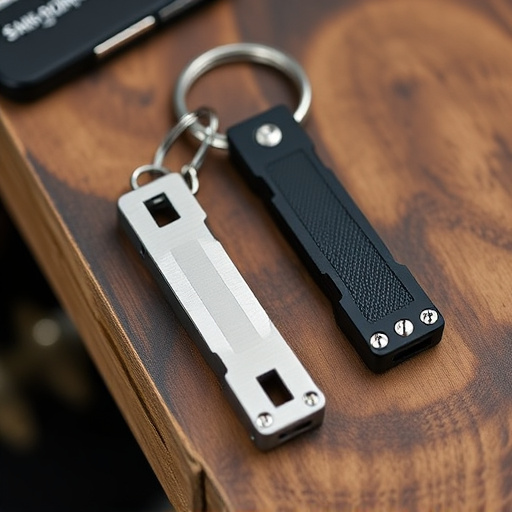Understanding local Legal Self Defense Keychain Regulations is vital before carrying such a device for personal safety. Global regulations vary based on crime rates and cultural contexts, with strict or relaxed laws depending on public safety concerns. Responsible ownership requires knowledge of legal permissions, safe handling, and awareness of consequences to ensure lawful self-defense.
“Discover the revolutionary world of covert protection keychains, a unique blend of functionality and discretion. This article explores the legal frameworks surrounding self-defense keychains, delving into their disguised design and the global regulations that shape their availability. From understanding the legalities to examining consumer rights, we navigate the intricate landscape of these innovative tools, highlighting the importance of responsible ownership in today’s diverse market. Uncover the essential guidelines for those seeking effective, yet discreet, self-defense solutions.”
- Understanding Legal Frameworks for Self-Defense Keychains
- Disguised Design: Unlocking Covert Protection Features
- Regulating Self-Defense Tools: Global Perspectives
- Consumer Rights and Responsibilities: Keychain Ownership
Understanding Legal Frameworks for Self-Defense Keychains
When considering a covert protection keychain, it’s crucial to understand the legal frameworks surrounding self-defense keychains in your region. Different countries and states have varying regulations on what constitutes a legal self-defense tool, with some having strict restrictions on the design, size, and functionality of such devices. For instance, some jurisdictions allow only certain types of non-lethal force, such as pepper spray or tasers, while others might prohibit all but the most basic self-defense mechanisms.
Legal Self Defense Keychain Regulations play a vital role in ensuring public safety and preventing misuse. These regulations are designed to balance an individual’s right to self-defense with the need to prevent accidental injuries or deaths. As such, it’s essential to research and understand your local laws before purchasing or carrying any self-defense keychain. This includes checking for any specific requirements on permitting, registration, and potential restrictions on where and how these devices can be used.
Disguised Design: Unlocking Covert Protection Features
In today’s world, where personal safety is a top priority, innovative solutions like the covert protection keychain have emerged as powerful tools for self-defense. Its disguised design is more than just an aesthetic appeal; it serves as a strategic element to ensure users’ well-being. This compact device seamlessly integrates functionality with secrecy, allowing individuals to access essential self-defense features discreetly.
The Legal Self Defense Keychain Regulations play a pivotal role in ensuring these tools are accessible while maintaining public safety. By understanding and adhering to these regulations, users can leverage the full potential of their covert protection keychains without legal repercussions. This balance between personal empowerment and regulatory compliance underscores the importance of staying informed about local laws, making it possible for folks to protect themselves effectively in various situations.
Regulating Self-Defense Tools: Global Perspectives
The regulation of self-defense tools, including discrete keychains designed for personal safety, varies greatly across global jurisdictions. While many countries have stringent laws controlling weapons and offensive devices, others take a more lenient approach, acknowledging the importance of accessible self-defense options for citizens. This disparity is often shaped by cultural norms, crime statistics, and historical contexts.
In regions with high crime rates or a history of violence, strict regulations on self-defense tools may be in place to maintain public safety. Conversely, areas prioritizing individual freedoms might have more relaxed Legal Self Defense Keychain Regulations, allowing citizens to arm themselves for protection without extensive government oversight. Understanding these global perspectives is essential for evaluating the role and design of covert protection keychains, ensuring they remain within legal boundaries while providing users with effective personal security solutions.
Consumer Rights and Responsibilities: Keychain Ownership
As a consumer, owning a Legal Self-Defense Keychain comes with both rights and responsibilities. While it offers added security and peace of mind, it’s crucial to understand the regulations surrounding such devices. The use of self-defense tools is heavily governed by local laws, which vary significantly from one region to another. It’s your responsibility to ensure that carrying and using a keychain for protection complies with these legal frameworks.
Knowing your rights and obligations is essential to protecting yourself legally. This includes being aware of permissible defense actions, stand-your-ground laws, and the potential consequences of using force or self-defense mechanisms inappropriately. Responsible ownership involves learning about safe storage, proper use, and immediate reporting of any incidents involving such devices, ensuring you remain within the confines of the law.
The disguised protection keychain represents a unique blend of functionality and discretion, offering individuals an innovative way to enhance their personal safety. By understanding the legal frameworks governing self-defense keychains and considering global regulations, consumers can make informed choices while navigating the responsibilities that come with owning such tools. As the demand for discreet self-defense options grows, further exploration and dialogue regarding consumer rights and responsible use are essential to ensure a safe and secure environment for all.
